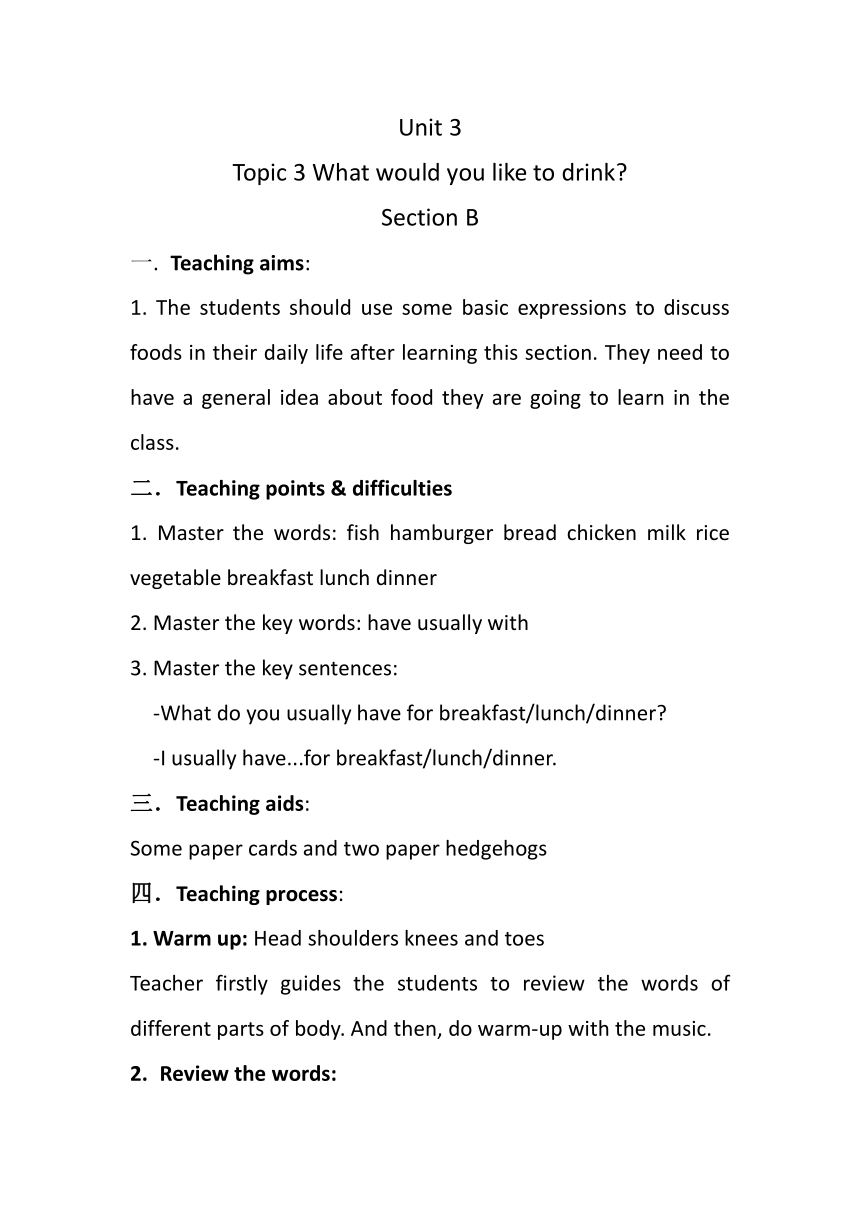仁爱科普版七年级上册Unit 3 Getting together Topic 3 What would you like to drink? Section B 教案
文档属性
| 名称 | 仁爱科普版七年级上册Unit 3 Getting together Topic 3 What would you like to drink? Section B 教案 |  | |
| 格式 | doc | ||
| 文件大小 | 24.0KB | ||
| 资源类型 | 教案 | ||
| 版本资源 | 仁爱科普版 | ||
| 科目 | 英语 | ||
| 更新时间 | 2022-10-04 10:01:07 | ||
图片预览

文档简介
Unit 3
Topic 3 What would you like to drink
Section B
1. Teaching aims:
1. The students should use some basic expressions to discuss foods in their daily life after learning this section. They need to have a general idea about food they are going to learn in the class.
二.Teaching points & difficulties
1. Master the words: fish hamburger bread chicken milk rice vegetable breakfast lunch dinner
2. Master the key words: have usually with
3. Master the key sentences:
-What do you usually have for breakfast/lunch/dinner
-I usually have...for breakfast/lunch/dinner.
三.Teaching aids:
Some paper cards and two paper hedgehogs
四.Teaching process:
1. Warm up: Head shoulders knees and toes
Teacher firstly guides the students to review the words of different parts of body. And then, do warm-up with the music.
2. Review the words:
Before starting the new section, teacher will review the words through paper cards and divide the whole class into 4 groups. There will be a competition game between different groups. (Teacher will use paper hedgehogs to mark their scores.)
3. Presentation
a. Before class
1. Teacher Shows students the pictures to lead in the topic. Then, review the words:
breakfast lunch dinner
Play the game of passing the word to review again.
2. Teach the key words & sentences:
have usually with
-What do you usually have for breakfast/lunch/dinner
-I usually have...for breakfast/lunch/dinner.
Invite different groups to practice these sentences.
b. While class
1. Ask students to listen to the materials and match the correct answers. In this part, teacher will check whether the students understand the conversation or not.
2. Show the students the conversation and learn it sentence by sentence. In this part, teacher will give more chance to students to practice more. There will be a role-play game between students and teacher. After that, teacher will divide the students into several groups and make a new dialogue by themselves. Pick some of them to play the conversation out.
c. After class:
Some blanks are designed for checking. Students need to give the teacher correct answers.
4. Conclusion:
In this class, students could easily use the sentences to communicate with each other. They could also express their ideas confidently. All of them enjoyed the class, so I achieved the goals of this class to help them use the key expressions in their daily life.
Topic 3 What would you like to drink
Section B
1. Teaching aims:
1. The students should use some basic expressions to discuss foods in their daily life after learning this section. They need to have a general idea about food they are going to learn in the class.
二.Teaching points & difficulties
1. Master the words: fish hamburger bread chicken milk rice vegetable breakfast lunch dinner
2. Master the key words: have usually with
3. Master the key sentences:
-What do you usually have for breakfast/lunch/dinner
-I usually have...for breakfast/lunch/dinner.
三.Teaching aids:
Some paper cards and two paper hedgehogs
四.Teaching process:
1. Warm up: Head shoulders knees and toes
Teacher firstly guides the students to review the words of different parts of body. And then, do warm-up with the music.
2. Review the words:
Before starting the new section, teacher will review the words through paper cards and divide the whole class into 4 groups. There will be a competition game between different groups. (Teacher will use paper hedgehogs to mark their scores.)
3. Presentation
a. Before class
1. Teacher Shows students the pictures to lead in the topic. Then, review the words:
breakfast lunch dinner
Play the game of passing the word to review again.
2. Teach the key words & sentences:
have usually with
-What do you usually have for breakfast/lunch/dinner
-I usually have...for breakfast/lunch/dinner.
Invite different groups to practice these sentences.
b. While class
1. Ask students to listen to the materials and match the correct answers. In this part, teacher will check whether the students understand the conversation or not.
2. Show the students the conversation and learn it sentence by sentence. In this part, teacher will give more chance to students to practice more. There will be a role-play game between students and teacher. After that, teacher will divide the students into several groups and make a new dialogue by themselves. Pick some of them to play the conversation out.
c. After class:
Some blanks are designed for checking. Students need to give the teacher correct answers.
4. Conclusion:
In this class, students could easily use the sentences to communicate with each other. They could also express their ideas confidently. All of them enjoyed the class, so I achieved the goals of this class to help them use the key expressions in their daily life.
同课章节目录
- Unit 1 Making new friends
- Topic 1 Welcome to China!
- Topic 2 Where are you from?
- Topic 3 How old are you?
- Unit 2 Looking different
- Topic 1 I have a small nose
- Topic 2 What does she look like?
- Topic 3 Whose jacket is this?
- Unit 3 Getting togethe
- Topic 1 Does he speak Chinese?
- Topic 2 What do your parents do?
- Topic 3 What would you like to drink?
- Unit 4 Having fun
- Topic 1 What can I do for you?
- Topic 2 Would you like to cook with us?
- Topic 3 What time is it now?
